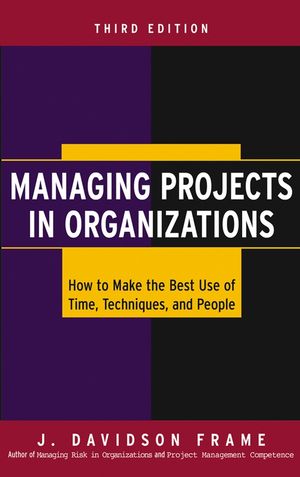Managing Projects in Organizations: How to Make the Best Use of Time, Techniques, and People, 3rd EditionISBN: 978-0-7879-6831-1
Hardcover
288 pages
October 2003, Jossey-Bass
 This is a Print-on-Demand title. It will be printed specifically to fill your order. Please allow an additional 10-15 days delivery time. The book is not returnable.
|
||||||
The Author.
1. The New Business Environment and the Need for a New Project Management.
The New Business Environment.
The Problem with the Traditional Approach to Project Management.
The New Project Management.
Traits of the New Project Manager.
The Increased Value of Project Managers.
Conclusions.
PART ONE: MANAGING IN THE NEW BUSINESS ENVIRONMENT.
2. Managing Complexity: Techniques for Fashioning Order Out of Chaos.
Chaos and Complexity.
Facets of Complexity.
Experience with Project Complexity.
How to Manage Complexity.
Conclusions.
3. Engaging Change: Knowing When to Embrace, Accept, or Challenge.
Sources of Change.
Change Management Strategies.
Going with the Flow of Rapid Prototyping.
Resisting Change with Configuration Management.
Basic Steps in Developing a System with Configuration Management.
Change Control.
Conclusions.
4. Managing Risk: Identifying, Analyzing, and Planning Responses.
Perspectives on Risk.
Risk and Variability.
Range of Risks.
Sources of Risk on Projects.
Risk-Reward Trade-Offs.
Risk and Time Horizons.
Risk Exposure.
Risk Management.
Modeling.
Conclusions.
5. Satisfying Customers: Knowing Who They Are, What They Want, and When They are Right or Wrong.
Who Are Our Customers?
Meeting Customer Expectations.
Understanding Customers’ Needs and Requirements.
Traits of Effective Needs Analysts.
Steps for Improving Needs Definition.
Customers’ Responsibilities in Defining Their Needs.
Organizing to Achieve Customer Satisfaction.
What to Do When Customers Don’t Cooperate.
Conclusions.
6. Defining Requirements that Bridge the Customer-Developer Gap.
The Place of Needs and Requirements in the Project Management Process.
Capturing Requirements.
Key Players in the Requirements Definition and Management Process.
The Communication Challenge: I Can’t Read Your Mind.
The Standard Communication Model.
Tips for Handling Requirements.
Bringing It Together with Joint Application Development JAD) · Conclusion
PART TWO: TOOLS FOR THE NEW PROJECT MANAGEMENT.
7. Acquiring Political Skills and Building Influence.
What Is Politics?
Politics in Projects.
Players to Contend with in the Project Environment.
Being a Better Politician.
A Guide to Action.
Building Authority.
Using Authority Effectively.
Managing Our Managers.
Conclusions.
8. Building Teams with Borrowed Resources.
Make the Team as Tangible as Possible.
Develop Rewards for Good Behavior.
Develop an Effective Personal Touch.
Self-Managed Teams: Prospectus and Pitfalls.
Structuring the Team.
Conclusions.
9. Selecting Projects That Will Lead to Success.
The Essence of Choice.
Benefit-Cost Ratios.
Buss’s Technique for Rank Ordering Projects.
Poor Man’s Hierarchy.
The Murder Board.
Peer Review.
General Rules for Selecting Projects.
Conclusions.
10. Estimating Realistic Costs, Schedules, and Specifications to Ensure Project Success.
Causes of Poor Estimation.
The 10 Percent Optimist.
Traditional Approaches to Cost Estimating.
Bottom-Up Versus Top-Down Estimates.
Life Cycle Cost Estimating.
Strategies for Dealing with Poor Estimates.
Conclusions.
11. Scheduling Projects with New Tools: The Time-boxed and Critical Chain Scheduling Techniques.
Time-boxed Scheduling.
What Needs to be Prioritized?
Bringing Together Pertinent Players.
What Needs to Be Prioritized.
Techniques for Prioritization.
The Use of Parallel Development.
Scheduling Realities.
The Need for Discipline.
Critical Chain Scheduling.
The Critical Chain and the Theory of Constraints.
The Critical Chain Perspective and the Psychology of Estimating Task Durations.
Using Buffers Effectively to Accelerate Project Delivery.
Project Buffers, Feeder Buffers, and Resource Buffers.
Conclusions.
12. Outsourcing to Control Costs, Focus on Core Work, and Expand Resources.
Forms of Outsourcing.
Outsourcing in Project Management.
Contracting.
Contracting: Preaward.
Contracting: Postaward.
Customer Acceptance and the Handover.
Conclusions.
13. Integrating Cost and Schedule Control to Measure Work Performance.
A Graphical Approach to Integrated Cost/Schedule Control.
The Fifty-Fifty Rule for Measuring Work Performance.
Other Ways to Calculate Earned Value.
An New Look at Cost and Schedule Variance.
Developing a New Vocabulary.
Case Study: The Bora Bora Officers Club.
Collecting Data.
Trend Analysis with the Earned-Value Approach.
When Is the Earned-Value Approach Appropriate?
A Historical Note.
Conclusions.
14. Evaluating Projects to Maintain Goals, Strengthen Accountability, and Achieve Objectives.
What is Evaluation?
Evaluations and the Project Life Cycle.
Problems with Evaluation.
Inherent Characteristics of Evaluation.
The Structured Walk-through.
Conclusions.
15. Understanding and Using Performance Metrics; or, Measuring the Right Stuff.
The Role of Measurement in Managing Projects.
The Nature of Measurement.
Generating Measures.
The Shadow Side of Measures.
Conclusions.
16. Establishing and Maintaining a Project Support Office to Strengthen Project Management Capabilities.
Traditional Project/Program Offices.
What Project Support Offices Do.
Where Should the Project Support Office Reside? · Staffing the Project Support Office.
Selling the Project Support Office.
17. Carpe Diem: Seize the Day!
Appendix: An Annotated Reading List for the New Project Management.
References.
Index.



